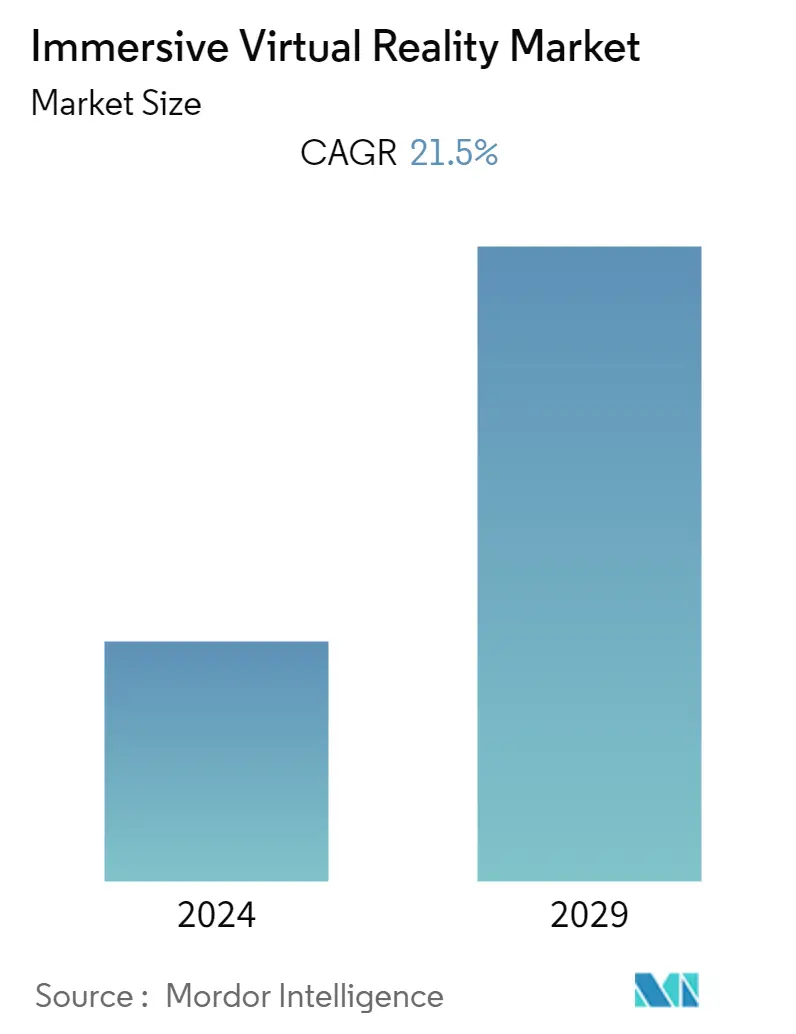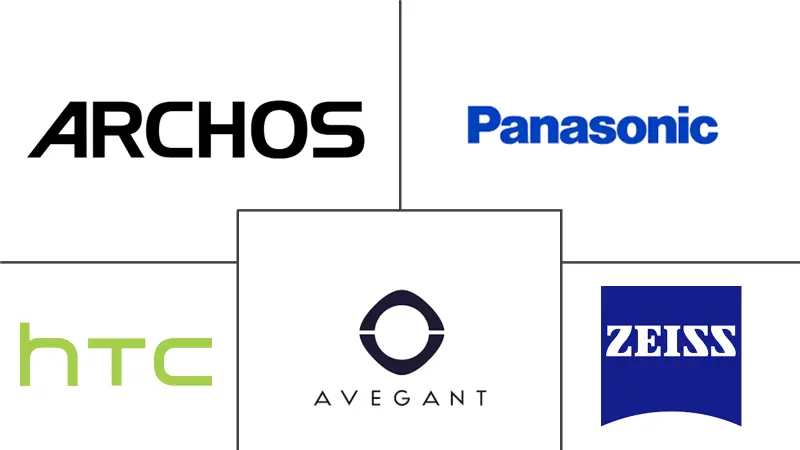Market Size of Immersive Virtual Reality Industry

| Study Period | 2019 - 2029 |
| Base Year For Estimation | 2023 |
| CAGR | 21.50 % |
| Fastest Growing Market | Asia-Pacific |
| Largest Market | North America |
| Market Concentration | Low |
Major Players
*Disclaimer: Major Players sorted in no particular order |
Immersive Virtual Reality Market Analysis
Immersive virtual reality market has registered a CAGR of 21.5% over the forecast period. The use of computer technology to simulate an environment is known as immersive virtual reality. Unlike the traditional user interface, VR places the user inside an experience. Instead of viewing a monitor screen in front of them, users are immersed and can interact with the 3D world. Technology has transformed the world by simulating as many senses as possible, such as vision, touch, hearing, and even smell.
- The implementation of immersive virtual reality is expected to be the future of the education industry. Virtual reality enables the risk-free practice of events that occur in the real world. VR has been instrumental in reducing the cost and risks associated with training, and thus, it has led to the adoption of technology across different industries.
- Cloud technologies are also promising scalability to immersive VR vendors. As VR-generated data increases, cloud services will store apps, data, and memory on virtual servers and stream them on demand. This is also expected to drive innovation in immersive VR and service updates in an uninterrupted cycle.
- Moreover, VR has also influenced the healthcare sector because it helped create a virtual environment for the surgeon. Real-time training involves expensive tools and equipment or hazardous conditions. The adoption of such technology is expected to expand horizons for the healthcare industry as a whole, which in turn will boost the market.
- But virtual reality devices are more expensive, which is stopping the market from growing during the time frame that was predicted.
- The COVID-19 crisis impacted several immersive VR tech companies. VR gaming centers were closed due to stay-at-home orders during the initial months of the pandemic. On the contrary, the consumer VR market witnessed a significant increase in adoption. During the lockdown, most people invested in immersive VR gaming as they aimed to explore new frontiers in gaming technology.
Immersive Virtual Reality Industry Segmentation
Immersive virtual reality involves the creation of simulated environments that imitate real objects or people to create an illusion. The creation of such an illusion helps people understand the actual environments of an industry, arena, space, or situation.Immersive virtual reality has applications across a wide array of industries, such as gaming and entertainment, defense, and healthcare, which are projected to bring in key revenues to the global market. The VR market for software includes apps, platforms, and content providers in the VR space.
The market sizes and forecasts are provided in terms of value (USD million) for all the above segments.
| By Device | |
| Gesture Tracking Devices | |
| Head Mounted Displays |
| By End-user Industry | |
| Entertainment & Gaming | |
| Aerospace & Defense | |
| Healthcare | |
| Education | |
| Other End-user Industries |
| Geography | |
| North America | |
| Europe | |
| Asia-Pacific | |
| Rest of World |
Immersive Virtual Reality Market Size Summary
The immersive virtual reality market is experiencing significant growth, driven by its transformative applications across various industries. Unlike traditional interfaces, immersive VR places users within a simulated environment, allowing for interaction with a 3D world through multiple senses. This technology is poised to revolutionize sectors such as education and healthcare by providing risk-free training environments and reducing costs associated with real-world training. The integration of cloud technologies is further enhancing the scalability and innovation of immersive VR, enabling seamless storage and streaming of VR-generated data. Despite the high costs of VR devices posing a challenge to market expansion, the consumer VR market saw increased adoption during the COVID-19 pandemic as individuals sought new gaming experiences.
North America holds a dominant position in the immersive virtual reality market, benefiting from a strong presence of industry players and a culture of innovation. The region's military and defense sectors are increasingly adopting VR for training simulations, leveraging significant government investments in military technology. Additionally, the education sector is exploring VR to enhance distance learning experiences, with initiatives like "Metaversities" gaining traction. The market is moderately competitive, with key players such as EON Reality, Sony Corporation, and Archos driving advancements through research and development. Recent collaborations, like those between Microsoft and Meta, and PrecisionOS and Siemens Healthineers, highlight the ongoing efforts to integrate VR into professional and medical training, further propelling market growth.
Immersive Virtual Reality Market Size - Table of Contents
-
1. MARKET DYNAMICS
-
1.1 Market Overview
-
1.2 Introduction to Market Drivers and Restraints
-
1.3 Market Drivers
-
1.3.1 Use of Virtual Reality in Aerospace & Defense for Training and Simulation
-
1.3.2 Penetration of HMDs in Gaming and Entertainment Sector
-
-
1.4 Market Restraints
-
1.4.1 High Product Cost
-
-
1.5 Industry Value Chain Analysis
-
1.6 Industry Attractiveness - Porter's Five Forces Analysis
-
1.6.1 Threat of New Entrants
-
1.6.2 Bargaining Power of Buyers/Consumers
-
1.6.3 Bargaining Power of Suppliers
-
1.6.4 Threat of Substitute Products
-
1.6.5 Intensity of Competitive Rivalry
-
-
-
2. MARKET SEGMENTATION
-
2.1 By Device
-
2.1.1 Gesture Tracking Devices
-
2.1.2 Head Mounted Displays
-
-
2.2 By End-user Industry
-
2.2.1 Entertainment & Gaming
-
2.2.2 Aerospace & Defense
-
2.2.3 Healthcare
-
2.2.4 Education
-
2.2.5 Other End-user Industries
-
-
2.3 Geography
-
2.3.1 North America
-
2.3.2 Europe
-
2.3.3 Asia-Pacific
-
2.3.4 Rest of World
-
-
Immersive Virtual Reality Market Size FAQs
What is the current Immersive Virtual Reality Market size?
The Immersive Virtual Reality Market is projected to register a CAGR of 21.5% during the forecast period (2024-2029)
Who are the key players in Immersive Virtual Reality Market?
Archos, Carl Zeiss AG, Sony Corporation, EON Reality and Oculus ( Facebook, Inc.) are the major companies operating in the Immersive Virtual Reality Market.

